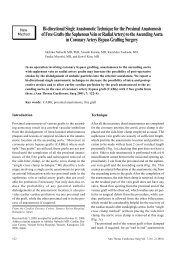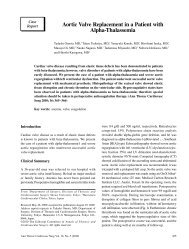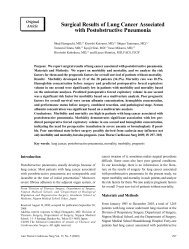Epidermal Growth Factor Receptor Gene Mutations in Early ... - Atcs.jp
Epidermal Growth Factor Receptor Gene Mutations in Early ... - Atcs.jp
Epidermal Growth Factor Receptor Gene Mutations in Early ... - Atcs.jp
Create successful ePaper yourself
Turn your PDF publications into a flip-book with our unique Google optimized e-Paper software.
Nakamura et al.<br />
Table 2. Association of EGFR mutations and cl<strong>in</strong>icopathologic<br />
features<br />
EGFR (exons 18, 19, 21)<br />
<strong>Factor</strong>s Mutation No mutation p value*<br />
Male 3 16 0.104<br />
Female 5 6<br />
Smoker 2 17 0.028**<br />
Non-smoker 6 5<br />
p-stage IA 5 10 0.682<br />
p-stages IB–IIIB 3 12<br />
*, Fisher’s exact probability test; **, significant difference.<br />
stage IA <strong>in</strong> 2 tumors, stage IIA <strong>in</strong> 1, stage IIB <strong>in</strong> 1, and<br />
stage IIIA <strong>in</strong> 1.<br />
<strong>Mutations</strong> <strong>in</strong> exon 21 were detected <strong>in</strong> three tumors,<br />
all <strong>in</strong> Noguchi type C and p-stage IA. All represented<br />
substitution of G for T at nucleotide 2573, result<strong>in</strong>g <strong>in</strong> an<br />
am<strong>in</strong>o acid substitution (L858R). No mutations were detected<br />
<strong>in</strong> exon 18.<br />
All EGFR mutations were detected only <strong>in</strong> adenocarc<strong>in</strong>omas,<br />
which showed a frequency of the EGFR mutations<br />
of 32% (8/25). Relationships between EGFR mutations<br />
and cl<strong>in</strong>icopathologic features are shown <strong>in</strong> Table<br />
2. Frequency of mutations did not differ between p-IA<br />
and the more advanced stages p-IB to IIIB (p=0.682).<br />
EGFR gene mutations were more frequent <strong>in</strong> patients who<br />
never smoked than <strong>in</strong> current or previous smokers<br />
(p=0.028). Although mutations were more frequent <strong>in</strong><br />
women (50%) than <strong>in</strong> men (15%), this difference was not<br />
statistically significant (p=0.104).<br />
Discussion<br />
In this study we <strong>in</strong>itially screened for mutations us<strong>in</strong>g<br />
PCR-SSCP, which enabled us to detect small amounts of<br />
abnormal tumor-derived DNA fragments among largest<br />
amounts of normal DNA derived from <strong>in</strong>terstitial tissue.<br />
We successfully detected mutations with<strong>in</strong> cod<strong>in</strong>g regions<br />
of the EGFR gene <strong>in</strong> 32% of unselected Japanese patients<br />
with adenocarc<strong>in</strong>oma. All gene mutations resulted <strong>in</strong><br />
changes of am<strong>in</strong>o acids. Lynch et al. 7) reported 10 tumors<br />
carry<strong>in</strong>g five types of EGFR mutations caus<strong>in</strong>g am<strong>in</strong>o<br />
acid alterations, 2 represent<strong>in</strong>g mutations that we also<br />
detected (E746–A750 del and L858R). Paez et al. 8) reported<br />
22 tumors carry<strong>in</strong>g four types of mutations, 3 be<strong>in</strong>g<br />
types that we detected. EGFR mutations detected <strong>in</strong><br />
seven studies <strong>in</strong>clud<strong>in</strong>g our present one 7,8,12–15) are summarized<br />
<strong>in</strong> Table 3. In all studies exons 19 and 21 represented<br />
“hot spots” for mutations, which frequently were<br />
found <strong>in</strong> non smokers and <strong>in</strong> women.<br />
Kosaka et al. 13) detected EGFR mutations more frequently<br />
<strong>in</strong> moderately and well differentiated adenocarc<strong>in</strong>omas<br />
than <strong>in</strong> poorly differentiated adenocarc<strong>in</strong>omas.<br />
This is of considerable <strong>in</strong>terest as gene mutations occurr<strong>in</strong>g<br />
<strong>in</strong> less <strong>in</strong>vasive cancers have been reported as relatively<br />
rare. Moreover, EGFR mutations are frequent <strong>in</strong><br />
tumors affect<strong>in</strong>g nonsmokers, while most altered genes<br />
<strong>in</strong> lung cancers such as RAS, p53, and FHIT were found<br />
more frequently <strong>in</strong> heavy smokers than <strong>in</strong> nonsmokers.<br />
Accord<strong>in</strong>g to the hypothesis of multistep carc<strong>in</strong>ogenesis,<br />
gene mutations tend to accumulate <strong>in</strong> late-stage disease<br />
or highly malignant cancers, a generalization that seems<br />
not to apply to EGFR mutations.<br />
Our present study disclosed EGFR mutations <strong>in</strong> earlystage<br />
adenocarc<strong>in</strong>omas. Noguchi’s pathologic classification<br />
9) represents an effort to depict the sequence of carc<strong>in</strong>ogenesis<br />
for peripherally located adenocarc<strong>in</strong>omas.<br />
When chest CT is used to screen for lung cancer, most<br />
peripheral small shadows show<strong>in</strong>g pure ground glass<br />
opacity prove to be atypical adenomatous hyperplasia or<br />
non<strong>in</strong>vasive bronchioloalveolar carc<strong>in</strong>oma, Noguchi types<br />
A and B. In our present study we found a po<strong>in</strong>t mutation<br />
<strong>in</strong> exon 21 <strong>in</strong> 3 Noguchi type C tumors, all represent<strong>in</strong>g<br />
p-IA disease. This suggests that exon 21 mutations <strong>in</strong> the<br />
EGFR gene may be relatively early occurences <strong>in</strong> the<br />
development of bronchioloalveolar carc<strong>in</strong>oma. In contrast,<br />
mutations <strong>in</strong> exon 19 were found <strong>in</strong> more advanced tumors<br />
such as Noguchi types D, E, and F. These results<br />
suggest the possibility that malignant grades of pulmonary<br />
adenocarc<strong>in</strong>oma may be related to mutation at different<br />
sites with<strong>in</strong> the EGFR gene. Although a relationship<br />
between exons affected and disease stage or adenocarc<strong>in</strong>oma<br />
subtype was not mentioned <strong>in</strong> previous studies,<br />
Tokumo et al. 14) reported significantly higher prevalence<br />
of mutations <strong>in</strong> exon 19 <strong>in</strong> tumors from men than<br />
women. M<strong>in</strong>na et al. 16) also suggested different biologic<br />
activities of different affected exons, given that po<strong>in</strong>t<br />
mutations <strong>in</strong> exon 21 are heterozygous, <strong>in</strong>clud<strong>in</strong>g one<br />
normal allele, while the normal allele is severely underrepresented<br />
<strong>in</strong> tumors with small exon 19 deletions. These<br />
differences may be related to disease stages, histopathologic<br />
grade, and l<strong>in</strong>eage of adenocarc<strong>in</strong>omas. We suspect<br />
that exon 21 is likely to be altered <strong>in</strong> the non<strong>in</strong>vasive<br />
Noguchi type A to C sequence (well differentiated<br />
bronchioloalveolar carc<strong>in</strong>oma), while exon 19 might be<br />
altered <strong>in</strong> more aggressive types such as D, E, and F.<br />
90<br />
Ann Thorac Cardiovasc Surg Vol. 13, No. 2 (2007)








